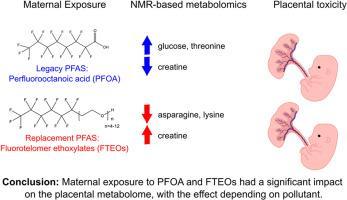当前位置:
X-MOL 学术
›
Chemosphere
›
论文详情
Our official English website, www.x-mol.net, welcomes your
feedback! (Note: you will need to create a separate account there.)
Differential impact of perfluorooctanoic acid and fluorotelomer ethoxylates on placental metabolism in mice
Chemosphere ( IF 8.1 ) Pub Date : 2024-04-08 , DOI: 10.1016/j.chemosphere.2024.141923
Haley Adams 1 , Jenna Hanrahan 1 , Sophie Kiefte 1 , Thomas O'Brien 1 , Grace V Mercer 1 , Katherine L Steeves 1 , Céline M Schneider 1 , Karl J Jobst 1 , Lindsay S Cahill 2
Chemosphere ( IF 8.1 ) Pub Date : 2024-04-08 , DOI: 10.1016/j.chemosphere.2024.141923
Haley Adams 1 , Jenna Hanrahan 1 , Sophie Kiefte 1 , Thomas O'Brien 1 , Grace V Mercer 1 , Katherine L Steeves 1 , Céline M Schneider 1 , Karl J Jobst 1 , Lindsay S Cahill 2
Affiliation

|
Poly- and perfluoroalkyl substances (PFAS) are a group of compounds with uses in industry and many consumer products. Concerns about the potential health effects of these compounds resulted in regulation by the Stockholm Convention on the use of three of the most common PFAS, including perfluorooctanoic acid (PFOA). Thousands of PFAS remain in production that are unregulated and for which their toxicity is unknown. Our group recently identified a new class of PFAS, fluorotelomer ethoxylates (FTEOs), in indoor dust and industrial wastewater. In this study, we investigated the effect of PFAS on placental metabolism by exposing healthy, pregnant CD-1 mice to PFOA or FTEOs at one of three concentrations (0 ng/L (controls), 5 ng/L, 100 ng/L) ( = 7–8/group). While PFOA is banned and PFOA concentrations in human blood are decreasing, we hypothesize that FTEOs will cause adverse pregnancy outcomes similar to PFOA, the compounds they were meant to replace. Placental tissue samples were collected at embryonic day 17.5 and H solid-state magic angle spinning nuclear magnetic resonance spectroscopy was used to determine the relative concentration of placental metabolites ( = 18–20/group). At the highest concentration, the relative concentrations of glucose and threonine were increased and the relative concentration of creatine was decreased in the PFOA-exposed placentas compared to controls (p < 0.05). In contrast, the relative concentrations of asparagine and lysine were decreased and the relative concentration of creatine was increased in the FTEOs-exposed placentas compared to controls (p < 0.05). Partial least squares - discriminant analysis showed the FTEOs-exposed and control groups were significantly separated (p < 0.005) and pathway analysis found four biochemical pathways were perturbed following PFOA exposure, while one pathway was altered following FTEOs exposure. Maternal exposure to PFOA and FTEOs had a significant impact on the placental metabolome, with the effect depending on the pollutant. This work motivates further studies to determine exposure levels and evaluate associations with adverse outcomes in human pregnancies.
中文翻译:

全氟辛酸和氟调聚物乙氧基化物对小鼠胎盘代谢的不同影响
多氟烷基物质和全氟烷基物质 (PFAS) 是一组用于工业和许多消费品的化合物。由于担心这些化合物对健康的潜在影响,《斯德哥尔摩公约》对三种最常见 PFAS 的使用进行了监管,其中包括全氟辛酸 (PFOA)。数以千计的 PFAS 仍在生产中,但不受监管,其毒性也未知。我们的团队最近在室内灰尘和工业废水中发现了一类新的 PFAS,即氟调聚乙氧基化物 (FTEO)。在这项研究中,我们通过将健康、怀孕的 CD-1 小鼠暴露于三种浓度(0 ng/L(对照)、5 ng/L、100 ng/L)之一的 PFOA 或 FTEO 中,研究了 PFAS 对胎盘代谢的影响。 (= 7–8/组)。虽然 PFOA 已被禁用,并且人类血液中的 PFOA 浓度正在下降,但我们假设 FTEO 会导致与 PFOA 类似的不良妊娠结局,而它们本来是要取代的化合物。在胚胎第17.5天收集胎盘组织样本,并使用H固态魔角旋转核磁共振波谱法测定胎盘代谢物的相对浓度(= 18-20/组)。在最高浓度下,与对照组相比,暴露于 PFOA 的胎盘中葡萄糖和苏氨酸的相对浓度增加,肌酸的相对浓度降低(p < 0.05)。相反,与对照组相比,暴露于 FTEO 的胎盘中天冬酰胺和赖氨酸的相对浓度降低,肌酸的相对浓度升高(p < 0.05)。偏最小二乘法 - 判别分析显示 FTEO 暴露组和对照组显着分离 (p < 0.005)和通路分析发现,PFOA 暴露后,四种生化通路受到干扰,而 FTEO 暴露后,一种通路发生改变。母亲接触 PFOA 和 FTEO 对胎盘代谢组有显着影响,其影响取决于污染物。这项工作激发了进一步的研究,以确定暴露水平并评估与人类妊娠不良结果的关联。
更新日期:2024-04-08
中文翻译:

全氟辛酸和氟调聚物乙氧基化物对小鼠胎盘代谢的不同影响
多氟烷基物质和全氟烷基物质 (PFAS) 是一组用于工业和许多消费品的化合物。由于担心这些化合物对健康的潜在影响,《斯德哥尔摩公约》对三种最常见 PFAS 的使用进行了监管,其中包括全氟辛酸 (PFOA)。数以千计的 PFAS 仍在生产中,但不受监管,其毒性也未知。我们的团队最近在室内灰尘和工业废水中发现了一类新的 PFAS,即氟调聚乙氧基化物 (FTEO)。在这项研究中,我们通过将健康、怀孕的 CD-1 小鼠暴露于三种浓度(0 ng/L(对照)、5 ng/L、100 ng/L)之一的 PFOA 或 FTEO 中,研究了 PFAS 对胎盘代谢的影响。 (= 7–8/组)。虽然 PFOA 已被禁用,并且人类血液中的 PFOA 浓度正在下降,但我们假设 FTEO 会导致与 PFOA 类似的不良妊娠结局,而它们本来是要取代的化合物。在胚胎第17.5天收集胎盘组织样本,并使用H固态魔角旋转核磁共振波谱法测定胎盘代谢物的相对浓度(= 18-20/组)。在最高浓度下,与对照组相比,暴露于 PFOA 的胎盘中葡萄糖和苏氨酸的相对浓度增加,肌酸的相对浓度降低(p < 0.05)。相反,与对照组相比,暴露于 FTEO 的胎盘中天冬酰胺和赖氨酸的相对浓度降低,肌酸的相对浓度升高(p < 0.05)。偏最小二乘法 - 判别分析显示 FTEO 暴露组和对照组显着分离 (p < 0.005)和通路分析发现,PFOA 暴露后,四种生化通路受到干扰,而 FTEO 暴露后,一种通路发生改变。母亲接触 PFOA 和 FTEO 对胎盘代谢组有显着影响,其影响取决于污染物。这项工作激发了进一步的研究,以确定暴露水平并评估与人类妊娠不良结果的关联。

































 京公网安备 11010802027423号
京公网安备 11010802027423号